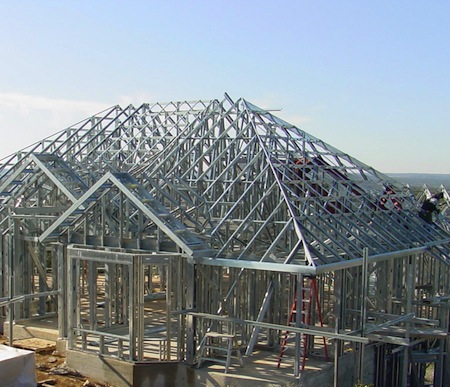Wood vs. Steel Framing
Steel framing is nearly universal in commercial and industrial applications, but steel doesn't get much attention when it comes to residential homes. For most homes, wood is king. Which is better? Let's look at steel (or other metal) framing, and some of its pros and cons.
What's the Deal with Steel?
Steel framing is getting a closer look from green home designers and builders for a variety of reasons. (In this article, we use the word 'steel,' but other metals such as aluminum are also used in framing. The word steel and metal can be used interchangeably here.) Steel, while definitely not a perfect material, has several attributes that may make it a good choice for framing a green home. Here are some of steel's more important advantages over traditional wood framing.
- Recycled Content: The steel used for construction framing contains a percentage of recycled content, typically around 60% or more. The use of recycled steel reduces its environmental impact by lowering the amount of virgin material and the energy needed to process it into a finished product.
- Durability: Steel is a very tough, durable material. Steel is less susceptible to damage from natural storms (especially hurricanes, earthquakes and tornadoes). Steel can easily withstand winds up to 160 mph.
- Resistant to Insect and Mold Damage: Steel is completely impervious to damage from insects such as termites that can devastate a wood-framed structure. Steel is also resistant to mold growth, another condition that can lead to health issues and weaken a wood structure over time.
Because of these factors, many insurance companies offer lower premiums for steel-framed homes, as they are less likely to suffer damage from these and other conditions.
- Longer Spans: Steel frames are capable of supporting much longer spans, one of the reasons they're commonly used in large commercial buildings. For larger homes, steel frames can support spans of up to 300 feet, compared to around 80 feet for wood.
- Less Waste, Less Time: Contractors with experience in steel framing can typically erect a steel structure in less time than a typical wood framing. Steel framing is also pre-cut, pre-drilled, pre-welded, and pre-punched; steel arrives at the build site ready to go, further reducing construction time and drastically reducing waste, a common problem with wood framing. Less waste means less money wasted, and less landfill use.
The price for steel framing may be a bit more than wood up-front, but its shorter construction times and long-term durability will typically offset these cost differentials over time.
Potential Downsides to Steel Framing
Despite all of its positive attributes, steel framing has one major drawback that simply has to be addressed if it is to be used in a residential setting (especially a 'green' home): thermal bridging.
Thermal bridging is a materials' ability to transmit heat or cold; in a home setting, a frame's high thermal bridging factor means it will be much harder to insulate the structure. More thermal bridging means the possibility of higher heating and cooling costs, unless the proper steps are taken to minimize the problem.
To minimize thermal bridging in a steel-framed structure, one solution commonly used is to place as much of the home's insulation on the exterior of the structure, rather than inside. Traditional batt-type insulation or other forms of interior insulation will not reduce the thermal bridging enough to save much energy. For example, insulating a steel-framed wall with R-19 fiberglass batt insulation will only result in R-5 or R-6 performance.
By putting all of the insulation on the outside of the steel frame, usually in the form of rigid or spray foam insulation, performance is greatly improved. Because thermal bridging can also contribute to moisture infiltration into the home, exterior insulation reduces this as well.
For those wanting more complete light and heat blockage, room darkening shades are a better option. A room darkening skylight shade is made from a thicker material and often has a reflective backing on it (such as a thin aluminum foil layer) to keep all light and solar energy from entering the skylight or roof window.
Wood or Steel?
The choice to use wood or steel framing is one that ultimately must be made by the homeowner with the consultation of the architect and builder.
There are obviously advantages to steel framing, especially in areas that experience prolonged periods of moisture and humidity or are susceptible to insect damage. Homes in natural disaster-prone areas can also benefit from steel.
If steel is used, special attention must be paid to the thermal bridging issue in order to ensure that the home's energy performance does not suffer. Architects and contractors experienced with steel framing should be aware of steel's special issues, and be able to remedy them.
For most homeowners, wood framing will continue to be the go-to material. It is the material tha builders have the most experience with, and is more widely available. If wood is used for a green home construction, always make sure it is sustainably-sourced wood from well-managed forests. This will reduce or eliminate issues with deforestation associated with unsustainably-sourced wood product.
comments powered by Disqus




























































































































































































